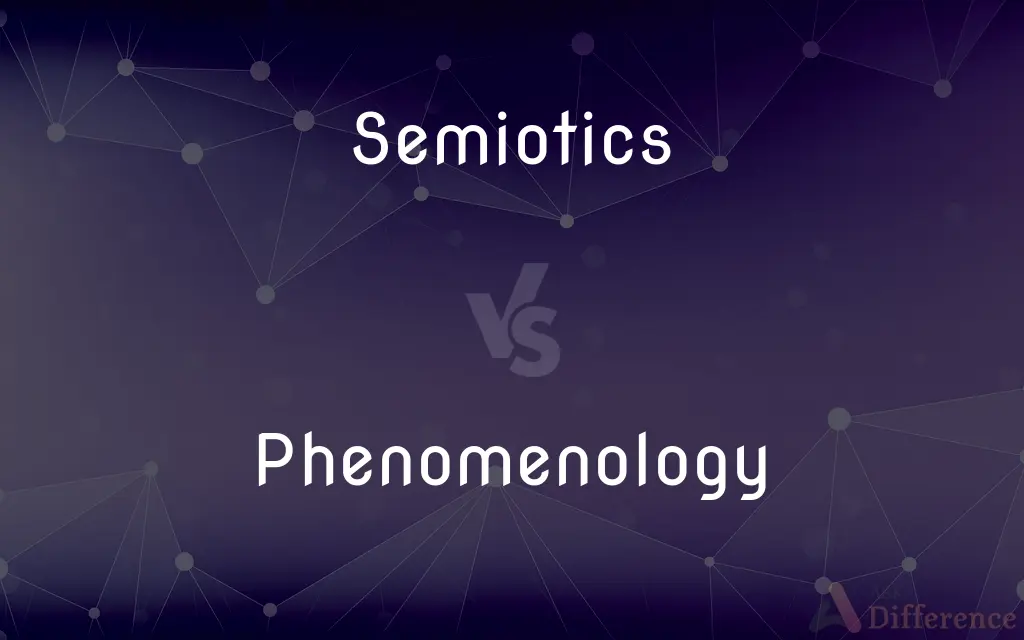Semiotics vs. Phenomenology — What's the Difference?
By Fiza Rafique & Maham Liaqat — Updated on May 17, 2024
Semiotics studies signs and symbols and their meanings, while phenomenology focuses on the structures of experience and consciousness.

Difference Between Semiotics and Phenomenology
Table of Contents
ADVERTISEMENT
Key Differences
Semiotics is the study of signs, symbols, and their use or interpretation. It examines how meaning is created and communicated through various signs and symbols in language, media, and culture. Phenomenology, on the other hand, is the philosophical study of the structures of experience and consciousness. It seeks to describe phenomena as they are experienced from the first-person perspective, emphasizing the importance of subjective perception and intentionality.
While semiotics analyzes the systems and processes by which meanings are conveyed through signs, phenomenology investigates how experiences and consciousness shape our understanding of reality. Semiotics is concerned with the external representations and their interpretations, whereas phenomenology delves into the internal experiences and the nature of consciousness.
Semiotics deals with the study of signs and meanings, while phenomenology explores the structures and experiences of consciousness.
Comparison Chart
Definition
Study of signs, symbols, and their meanings
Philosophical study of experience and consciousness
Focus
Meaning creation and communication
Structures of experience from first-person perspective
ADVERTISEMENT
Key Concepts
Signifier, signified, encoding, decoding
Subjective perception, intentionality
Methodology
Analyzing signs and symbols in various contexts
Describing phenomena as experienced
Scope
Language, media, culture
Consciousness, perception, experience
Origin
Linguistics, cultural studies
Philosophy, particularly Edmund Husserl's work
Compare with Definitions
Semiotics
Examination of the relationship between signifier and signified.
Semiotics explores how the word tree (signifier) represents the concept of a tree (signified).
Phenomenology
Philosophical study of the structures of experience and consciousness.
Phenomenology seeks to describe the experience of time from a first-person perspective.
Semiotics
Analysis of how meaning is created and communicated.
In literature, semiotics examines how metaphors contribute to the narrative.
Phenomenology
Focus on subjective perception and intentionality.
Phenomenology examines how we perceive and give meaning to everyday objects.
Semiotics
The study of signs and symbols and their use or interpretation.
Semiotics helps us understand how advertising uses symbols to convey messages.
Phenomenology
Emphasis on first-person perspective in understanding reality.
Phenomenology studies how our consciousness shapes our understanding of reality.
Semiotics
Understanding the encoding and decoding of messages.
Media semiotics analyzes how audiences interpret televised content.
Phenomenology
Describing phenomena as they are experienced, without bias.
A phenomenological approach would explore how people experience and describe pain.
Semiotics
Study of sign systems in cultural contexts.
The semiotics of fashion looks at how clothing choices communicate social identity.
Phenomenology
A philosophy or method of inquiry concerned with the perception and experience of objects and events as the basis for the investigation of reality.
Semiotics
Semiotics (also called semiotic studies) is the study of sign processes (semiosis), which are any activity, conduct, or process that involves signs, where a sign is defined as anything that communicates a meaning that is not the sign itself to the sign's interpreter. The meaning can be intentional such as a word uttered with a specific meaning, or unintentional, such as a symptom being a sign of a particular medical condition.
Phenomenology
A philosophical movement based on this, originated by Edmund Husserl around 1905.
Semiotics
The theory and study of signs and symbols, especially as elements of language or other systems of communication, and comprising semantics, syntactics, and pragmatics.
Phenomenology
(philosophy) The study of structures of consciousness as experienced from the first-person point of view.
Semiotics
The study of signs and symbols, especially as means of language or communication.
Social science
Phenomenology
(philosophy) A movement based on this, originated about 1905 by Edmund Husserl.
Semiotics
(dated) The study of medical signs and symptoms; symptomatology.
Phenomenology
(medicine, philosophy of medical sciences) An approach to clinical practice which places undue reliance upon subjective criteria such as signs and symptoms, while ignoring objective etiologies in the formulation of diagnoses and in the compilation of a formal nosologies.
Semiotics
Same as Semeiotics.
Phenomenology
(physics) The use of theoretical models to make predictions that can be tested through experiments.
Semiotics
(philosophy) a philosophical theory of the functions of signs and symbols
Phenomenology
A description, history, or explanation of phenomena.
Phenomenology
A philosophical doctrine proposed by Edmund Husserl based on the study of human experience in which considerations of objective reality are not taken into account
Phenomenology
Investigation into the essence of experiences.
Phenomenology aims to uncover the fundamental nature of our interactions with the world.
Common Curiosities
How does semiotics approach the concept of meaning?
Semiotics analyzes how meaning is created and communicated through signs and symbols.
Can semiotics be applied to media studies?
Yes, semiotics is often used to analyze how media conveys messages and meanings.
What is phenomenology?
Phenomenology is the philosophical study of the structures of experience and consciousness.
How does phenomenology approach the concept of experience?
Phenomenology describes experiences from the first-person perspective, focusing on subjective perception.
What is semiotics?
Semiotics is the study of signs, symbols, and their meanings.
What is the key difference between semiotics and phenomenology?
Semiotics focuses on the study of signs and meanings, while phenomenology explores the structures and experiences of consciousness.
What is a signifier in semiotics?
A signifier is the form of a sign, such as a word, image, or sound.
How does semiotics relate to linguistics?
Semiotics is closely related to linguistics as it studies how signs and symbols function in language.
Can phenomenology be applied to psychology?
Yes, phenomenology can help explore subjective experiences and consciousness in psychological contexts.
Who are some key figures in semiotics?
Key figures in semiotics include Ferdinand de Saussure and Charles Sanders Peirce.
Who are some key figures in phenomenology?
Key figures in phenomenology include Edmund Husserl and Martin Heidegger.
What is intentionality in phenomenology?
Intentionality refers to the directedness of consciousness towards objects, experiences, or states of affairs.
Can semiotics help in understanding cultural symbols?
Yes, semiotics helps analyze and interpret cultural symbols and their meanings.
Can phenomenology help in understanding personal experiences?
Yes, phenomenology seeks to describe and understand personal experiences from the first-person perspective.
How does phenomenology relate to philosophy?
Phenomenology is a branch of philosophy that examines the structures of experience and consciousness.
Share Your Discovery

Previous Comparison
Character vs. Word
Next Comparison
Pentecost vs. WhitsunAuthor Spotlight
Written by
Fiza RafiqueFiza Rafique is a skilled content writer at AskDifference.com, where she meticulously refines and enhances written pieces. Drawing from her vast editorial expertise, Fiza ensures clarity, accuracy, and precision in every article. Passionate about language, she continually seeks to elevate the quality of content for readers worldwide.
Co-written by
Maham Liaqat















































